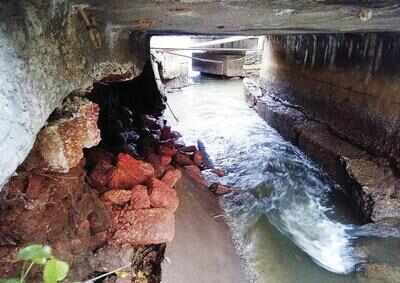Base of Ribandar causeway damaged, plans to shut bridge

The area near the corroded archway is used for Ganesh visarjan and the damage was noticed by a group of boys who had gone there to clear the spot. They raised an alarm following which the PWD shut down one lane of the causeway and is considering shutting it completely until major repairs are carried out
Panaji: One lane of the historic Ribandar Causeway, built during the Portuguese era, has been shut for traffic from Monday after the base under an archway was seen to have corroded. While traffic is allowed to flow on one-lane of the causeway for now, the PWD is considering shutting down the structure until major repairs are carried out, sources said.
“There is a spot used for Ganesh visarjan near the archway and when a group of boys went there on Monday to clean up the spot for the immersion, they noticed that the base of the archway had severely corroded. They raised an alarm and one lane of the causeway has been shut down for now,” said an official.
The full extent of the damage could not be assessed on Monday as the PWD is in the process of procuring a canoe to inspect the site. The inspection will have to be timed during low-tide so that more of the structure is visible, a department source said.
“As the causeway is around 400 years old, though it is not a protected structure, the PWD will have to seek permission from the Archeological Survey of India (ASI) to carry out repairs. We are moving a file immediately. As per ASI rules, a NOC is required from them for the repair of such old structures. Therefore, it may take some time before we are able to take up the repairs,” said a PWD official.
In November last year, a half-a-meter section of the Ribandar causeway had sunk in and was later repaired.
The historic Ponte de Linhares (Linhares bridge) was constructed by the Portuguese to link Panaji to Old Goa via the village of Ribandar. The bridge was once considered the longest in Asia. Built in 1634 for horse-drawn carriages, it has withstood the devastation of time and is today used by all kinds of traffic, including buses.
Officials say the bridge can survive a few more years if traffic is phased out or brought to a complete stop.
“There is a spot used for Ganesh visarjan near the archway and when a group of boys went there on Monday to clean up the spot for the immersion, they noticed that the base of the archway had severely corroded. They raised an alarm and one lane of the causeway has been shut down for now,” said an official.
The full extent of the damage could not be assessed on Monday as the PWD is in the process of procuring a canoe to inspect the site. The inspection will have to be timed during low-tide so that more of the structure is visible, a department source said.
“As the causeway is around 400 years old, though it is not a protected structure, the PWD will have to seek permission from the Archeological Survey of India (ASI) to carry out repairs. We are moving a file immediately. As per ASI rules, a NOC is required from them for the repair of such old structures. Therefore, it may take some time before we are able to take up the repairs,” said a PWD official.
In November last year, a half-a-meter section of the Ribandar causeway had sunk in and was later repaired.
The historic Ponte de Linhares (Linhares bridge) was constructed by the Portuguese to link Panaji to Old Goa via the village of Ribandar. The bridge was once considered the longest in Asia. Built in 1634 for horse-drawn carriages, it has withstood the devastation of time and is today used by all kinds of traffic, including buses.
Officials say the bridge can survive a few more years if traffic is phased out or brought to a complete stop.
FOLLOW US ON SOCIAL MEDIA
FacebookTwitterInstagramKOO APPYOUTUBE
Start a Conversation
end of article









